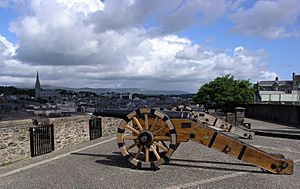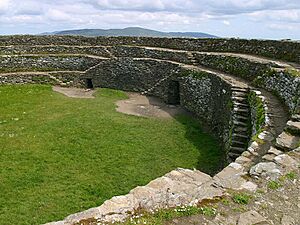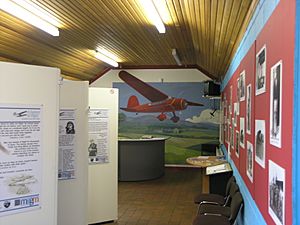History of Derry facts for kids

The history of Derry goes back to the 6th century. That's when a monastery was first built there. But people have found even older things and places from before that time. The name Derry comes from an old Irish word, Doire. It means 'oak grove' or 'oak wood'.
Contents
Early Times in Derry
Around the 500s, a Christian monastery was started on a hill called Doire. This hill was east of the River Foyle. A local king, who had a fort there, supposedly gave the land for the monastery.
Legend says that Saint Colmcille started the Doire monastery. Colmcille founded many important monasteries in Ireland and Scotland. These include Durrow Abbey and Iona. It's not totally certain he started the Derry settlement. However, the monastery belonged to a group of churches that looked to Colmcille as their leader.
Local stories say the first church was where St. Columba's Long Tower Church is today. This was also the site of an old cathedral. It was later destroyed in 1568. Near it was an old Irish round tower. Over time, the Derry monastery became an Augustinian group. A small church from this monastery lasted until the 1600s. It was used by the first settlers from London when they built the walled city.
Even though Vikings sailed up the rivers nearby, the Derry monastery mostly avoided their attacks. In the 1100s and 1200s, Norman settlers came to Derry. By the early 1300s, Richard de Burgh, the Earl of Ulster, owned Derry. It was part of his Earldom until it fell apart.
The Plantation of Ulster
After the Earldom of Ulster collapsed in the 1300s, Irish rule grew stronger. In the late 1500s, Queen Elizabeth I of England tried to take control of Ulster. This was the only part of Ireland not under English rule.
The English first came to Derry in 1566. But their army base only lasted a few years. A more successful army came back in 1600. This was during the Nine Years War against the Irish leaders, the O'Neill and O'Donnell families. This time, the English held onto Derry. When the war ended in 1603, a small trading town was set up. It was given the legal status of a city.
In 1608, during O'Doherty's Rebellion, this new city was attacked. Sir Cahir O'Doherty, an Irish chief, almost completely destroyed it. This attack happened soon after the Flight of the Earls. This was when the O'Neill and O'Donnell chiefs left Ireland. This left Irish Ulster without its main leaders.
The new king in London, James I, had a new plan. He wanted to bring Ulster under control for good. This plan was called the 'Plantation of Ulster'. It meant bringing loyal English and Scottish settlers to the area. These new settlers were to be Protestant.
Part of this plan was run by rich trading groups from the City of London. In 1623, the new area given to these London groups was renamed Londonderry. This was to honor their connection. The fortified city, built across the River Foyle, was also renamed. At this time, King James I gave the city a special Royal Charter. Today, people still debate whether to use "Derry" or "Londonderry".
The City of Londonderry was very important to the Ulster Plantation. It was planned using the best ideas for town design from Europe. Its original street layout is still mostly the same today. Most importantly, the city was surrounded by huge stone walls. It was the last walled city built in Ireland. It is also the only city on the island whose old walls are still completely standing.
One of the city's new buildings was St. Columb's Cathedral (built in 1633). This is a very important building from the 1600s. It was the first Protestant cathedral built anywhere in the world after the Reformation.
Civil Wars and Sieges
The new city grew slowly. By the 1680s, it still only had about 2,000 people. But it was still the biggest town in Ulster. Like most of Britain and Ireland, the city faced big problems in the 1640s. This started with the Irish Rebellion of 1641. Irish rebels attacked the city but failed.
For the next ten years of war, Derry became a strong place for British Protestant settlers. They formed an army to defend themselves. However, these Protestants disagreed about the English Civil War. Some supported the King, some the English Parliament, and some the Scottish Covenanters.
In 1649, the city and its army, which supported the Parliament in London, were surrounded. This was done by Scottish Presbyterian forces loyal to King Charles I. The Parliamentarians in Derry were helped by a strange team-up. This included Parliament troops and the Irish Catholic general Owen Roe O'Neill. But these temporary friends soon fought each other again. This happened after the New Model Army landed in Ireland in 1649. The war in Ulster ended when the Parliamentarians defeated the Irish Catholic army in Donegal in 1650.
In 1688, Ireland became a battleground for the Glorious Revolution in England. This was when James II was removed from power by William of Orange. Catholic Ireland strongly supported James. But many Protestants in Ulster secretly supported William.
James II wanted all strong places in Ireland to be held by armies loyal to him. By November 1688, only Londonderry and nearby Enniskillen had Protestant armies. An army of about 1,200 men, mostly Scottish Highlanders, was slowly put together. When they arrived on December 7, 1688, the city gates were closed against them. This started the Siege of Derry.
On April 18, 1689, King James came to the city. He asked it to give up. But the King was turned away. Some of the brave defenders even fired at him. Tradition says that young apprentice boys closed the gates and saved the city. As the city decided not to surrender, the forces outside began the famous Siege of Derry.
For 105 days, the city suffered terribly. Cannonballs and bombs rained down. Hunger and sickness caused many deaths. Conditions for the attackers were also bad, and thousands died both inside and outside the walls. You can still see the cannons used to defend the city on the walls today. Finally, at the end of July, a relief ship broke through a barrier across the river. The Siege was over. This event has left a lasting mark on the city's traditions, remembered by groups like the Apprentice Boys of Derry.
18th and 19th Centuries
The city was rebuilt in the 1700s. Many beautiful Georgian style houses from that time still stand. George Berkeley, an important Irish thinker, was a church leader in Derry (1724–33). Another well-known church leader, Frederick Augustus Hervey, was the Bishop of Derry (1768–1803). Hervey, known as the Earl Bishop, built the city's first bridge across the River Foyle in 1790.
During the 1700s and 1800s, the port became a key place for Irish emigrants. They left for North America. Some of them started a new settlement called Nutfield, later named Londonderry, in New Hampshire. By the mid-1800s, a busy shirt and collarmaking industry grew here. This gave the city many of its impressive factory buildings. Four different railway lines started from the city. You can learn about their history at the Foyle Valley Railway Centre.
The city became a university city when Magee College joined the Royal University of Ireland in 1880. Magee College is still a university campus today, part of the University of Ulster.
Partition and World War II
The early 1920s in Ireland saw a lot of fighting. This was about whether Ireland should be independent. During the Irish War of Independence, Derry had serious clashes between different groups. This was partly due to the war between the Irish Republican Army and British forces. It was also due to money and social problems.
In July 1920, thousands of former British soldiers, who supported British rule, attacked Catholic areas. They saw these areas as rebellious. Serious riots followed. Many lives were lost. Many Catholics and Protestants were forced from their homes. After a week of violence, the British Army stepped in. Local politicians then worked out a difficult peace agreement.
In 1921, after the Anglo-Irish Treaty, Ireland was divided. Derry suddenly became a border city. Much of its natural trading area in County Donegal was cut off.
Amelia Earhart gave the city a much-needed boost in 1932. She landed here, becoming the first woman to fly alone across the Atlantic. Her connection to the city is shown at the Amelia Earhart Cottage in Ballyarnett.
During the Second World War, the city played an important role in the Battle of the Atlantic. The Royal Navy had a large presence there. Many American soldiers also arrived in the city. At the end of the war, 19 German U-boats surrendered in Derry's harbor.
The Troubles
Derry felt it was treated unfairly by the government in Northern Ireland. This was true both politically and economically. In the late 1960s, the city became a key place for arguments about unfair treatment and gerrymandering. Gerrymandering means drawing voting areas in a way that gives one group an unfair advantage. Even though most people in Derry were Irish nationalists, the city was always controlled by unionists. This was because of how the voting areas were drawn.
Also, the city had very high unemployment and poor housing. Many blamed the unionist government for overcrowding in nationalist areas. They felt the government wanted to keep Catholics in a few voting areas. Another big issue was that the authorities did not want to give Derry the new University of Ulster. Instead, the university was given to Coleraine, a town with mostly unionist residents.
Civil rights protests were made illegal. Police then used force to stop them. Catholics were often attacked after parades by loyalists. Events after the August 1969 Apprentice Boys parade led to the Battle of the Bogside. Catholic protesters fought the police. This led to widespread disorder in Northern Ireland. Many people see this as the start of the Troubles.
The city is often called "the cockpit of the Troubles" because so much happened there. On Sunday, January 30, 1972, 13 unarmed civilians were shot dead. This happened during a civil rights march in the Bogside area. British paratroopers did the shooting. Another 13 people were hurt, and one more person later died from their injuries. This event became known as Bloody Sunday.
Because of these events, some areas of Derry strongly supported republican armed groups. Until 1972, both the Provisional Irish Republican Army and Official IRA were active in the city. However, in 1972, the Official IRA stopped fighting. This was after they killed an 18-year-old local who was on leave from the British Army. The Provisional IRA, however, kept attacking security targets and bombing Derry's city center. The city center "looked as if it had been bombed from the air," according to Eamonn McCann. Martin McGuinness was a well-known local Provisional IRA member. After 1974, a smaller group, the Irish National Liberation Army, also became active in the city. All three INLA prisoners who died in the 1981 Irish hunger strike were from Derry and County Londonderry.
The violence in Derry became less intense towards the end of the Troubles in the 1990s. Street riots were still common, but the worst violence moved to Belfast. Some say that republican leaders in Derry agreed to a ceasefire as early as 1991. Whether true or not, the city did see less bloodshed by this time compared to Belfast or other places.
Derry has become known worldwide because of the Troubles. But it's also known for something else. The Civic Trust in London voted it one of the ten best cities of its kind to live in, in the United Kingdom.
Images for kids





